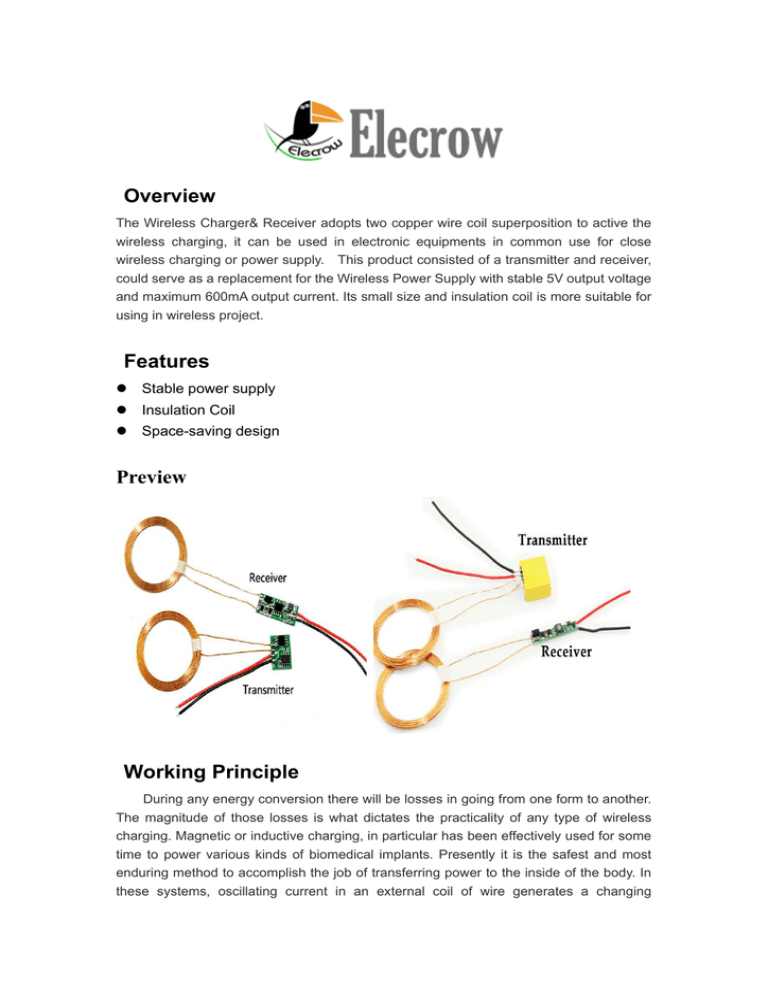Overview Features Preview Working Principle
advertisement

Overview The Wireless Charger& Receiver adopts two copper wire coil superposition to active the wireless charging, it can be used in electronic equipments in common use for close wireless charging or power supply. This product consisted of a transmitter and receiver, could serve as a replacement for the Wireless Power Supply with stable 5V output voltage and maximum 600mA output current. Its small size and insulation coil is more suitable for using in wireless project. Features Stable power supply Insulation Coil Space-saving design Preview Working Principle During any energy conversion there will be losses in going from one form to another. The magnitude of those losses is what dictates the practicality of any type of wireless charging. Magnetic or inductive charging, in particular has been effectively used for some time to power various kinds of biomedical implants. Presently it is the safest and most enduring method to accomplish the job of transferring power to the inside of the body. In these systems, oscillating current in an external coil of wire generates a changing magnetic field which induces a voltage inside an implanted coil. The current resultant from this voltage can charge a battery or power the device directly. While a moving magnet might just as well be used to externally generate the field, an external coil is simply more practical. Apple has just filed a patent for hardware which could make the shake to charge concept a reality, at least in theory. They claim a unique design incorporating internal moveable magnets, and a flat printed circuit board coil. Current chip efficiencies will however preclude practical implementation of this scheme for some time. Many smartphone users will be wondering wonder whether their near field communication (NFC) chip can be used to harvest power from a dedicated external source, or perhaps an ambient electromagnetic source like WiFi. In theory it is possible and such systems are on the market already, however not every NFC chip would be up to the task. To achieve maximum efficiency the system should be optimized for a resonant condition. Resonance in an electromagnetic system can be likened to pushing a child on swing only when the swing is at the high point. Anywhere else and the energy transferred to the child will be reduced. If the separation distance is no more than a quarter of the wavelength, such a system can operate at efficiencies up to 35%. One thing to keep in mind when considering wireless charging: If your charging system is throwing away nearly all of the 10 or so amps available from your wall outlet just to provide you with convenient at-a-distance charging, not only will charging be wasteful but it will be slow. Other wireless charging technologies relying on ultrasound or solar power are being developed, for example by Ubeam. For the time being, however, magnetic inductive charging technologies — spearheaded by the Qi consortium and smartphones like the Nokia Lumia 920 — such have taken the stage. Specifications Input Voltage 5~12V Output Voltage 5V Output Current 600mA Transmitter Coil Inductance 30uH Transmit-Receive Distance 1-20mm Coil Diameter 38mm Coil Height 2mm The transmitter coil and the receiving coil distance is 1 to 20 mm, if a small current may be appropriate to increase the number of turns of the receiver coil to increase the transmission distance. Transmitter coil: copper wire diameter φ0.6mm outer coil diameter 40mm, around the 20-turn, with the transmitting coil of the receiving coil, the transmitter coil connected to the 12V power: standby operating current of 300mA, the load is 4.2V600mAH polymer lithium battery. Transceiver from the receiver output voltage of 4.2V lithium battery charging current if the receiving distance further need to increase when more coil turns, the practical application, to adjust the number of turns of the coil to adjust the power Distance Voltage Current 1mm 5V 600mA 2mm 5V 450mA 3mm 5V 360mA 4mm 5V 310mA 5mm 5V 240mA 6mm 5V 210mA 7mm 5V 162mA 8mm 5V 150mA 9mm 5V 132mA 10mm 5V 120mA 11mm 5V 110mA 12mm 5V 70mA 13mm 5V 54mA 14mm 5V 41mA 15mm 5V 28mA 16mm 5V 19mA 17mm 5V 17mA 18mm 5V 10mA www.elecrow.com


